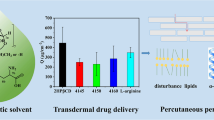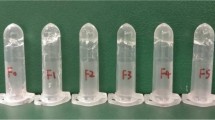Abstract
Deep eutectic solvents (DESs) based on choline chloride (C) and l-(+)-tartaric acid diethyl ester (L) were prepared and used in transdermal drug delivery system (TDDS). The internal chemistry structure including the formation and changes of hydrogen bonds of choline chloride and l-(+)-tartaric acid diethyl ester DES was characterized via attenuated total reflection Fourier transform infrared (ATR-FTIR) and 1H nuclear magnetic resonance (1H NMR) spectroscopy. The stoichiometric ratio of choline chloride to l-(+)-tartaric acid diethyl ester as well as water content affected the viscosity, glass transition temperature (Tg), and drug solubility of the DES. The viscosity and glass transition temperature of the DES (CL14) prepared at the ratio of 1:4 of choline chloride to l-(+)-tartaric acid diethyl ester were 1.19 Pa·s and − 44.01°C, respectively, and decreased to 0.10 Pa·s and − 55.31°C when 10% water (CL1410) was added. Taking diclofenac diethylamine (DDEA), the nonsteroidal anti-inflammatory drug as model, drug solubility was as high as 60 mg/ml and 250 mg/ml in CL14 and CL1410, respectively. The cumulative amount of DDEA was 4.63 ± 2.67 μg/cm2 and 15.27 ± 4.63 μg/cm2 for CL14 and CL1410, respectively, at 8 h. The mechanism of percutaneous permeability by the DES may be the disturbance of stratum corneum (SC) lipids as well as changes in the protein conformations. CL14 and CL1410 were also verified as low-cytotoxic and nonirritant. Therefore, the DESs studied are promising to be used in drug solubilization enhancement and transdermal drug delivery system.
Graphical abstract










Similar content being viewed by others
References
Panchaxari DM, Pampana S, Pal T, Devabhaktuni B, Aravapalli AK. Design and characterization of diclofenac diethylamine transdermal patch using silicone and acrylic adhesives combination. Daru. J Pharm Sci. 2013;21:1–14.
John V. The pharmacokinetics and metabolism of diclofenac sodium (Voltarol) in animals and man. Rheumatol Rehabil. 1979:22–37.
Sengupta S, Banerjee S, Sinha B, Mukherjee B. Improved skin penetration using in situ nanoparticulate diclofenac diethylamine in hydrogel systems: in vitro and in vivo studies. AAPS PharmSciTech. 2016;17:307–17.
Bhanu PV, Shanmugam V, Lakshmi P. Development and optimization of novel diclofenac emulgel for topical drug delivery. Int J Pharm. 2011;2:1–4.
Abbott AP, Capper G, Davies DL, Rasheed RK, Tambyrajah V. Novel solvent properties of choline chloride/urea mixtures. Chem Commun. 2003;70-1.
Hansen BB, Spittle S, Chen B, Poe D, Zhang Y, Klein JM, et al. Deep eutectic solvents: a review of fundamentals and applications. Chem Rev. 2021;121:1232–85.
Smith EL, Abbott AP, Ryder KS. Deep eutectic solvents (DESs) and their applications. Chem Rev. 2014;114:11060–82.
Hattori T, Tagawa H, Inai M, Kan T, Kimura SI, Itai S, et al. Transdermal delivery of nobiletin using ionic liquids. Sci Rep. 2019;9(1):1–11.
Dharamdasani V, Mandal A, Qi QM, Suzuki I, Bentley M, Mitragotri S. Topical delivery of siRNA into skin using ionic liquids. J Control Release. 2020;323:475–82.
Cai C, Yu W, Wang C, Liu L, Li F, Tan Z. Green extraction of cannabidiol from industrial hemp (Cannabis sativa L.) using deep eutectic solvents coupled with further enrichment and recovery by macroporous resin. J Mol Liq. 2019;287:110957.
Chen Y, Wang J, Cun D, Wang M, Jiang J, Xi H, et al. Effect of unsaturated menthol analogues on the in vitro penetration of 5-fluorouracil through rat skin. Int J Pharm. 2013;443:120–7.
Phaechamud T, Tuntarawongsa S, Charoensuksai P. Evaporation behavior and characterization of eutectic solvent and ibuprofen eutectic solution. AAPS PharmSciTech. 2016;17:1213–20.
Jain AK, Thomas NS, Panchagnula R. Transdermal drug delivery of imipramine hydrochloride. I. Effect of terpenes. J Control Release. 2002;79:93–101.
Shang L, Cun D, Xi H, Fang L. An explanation for the difference in the percutaneous penetration behavior of tamsulosin induced by two different O-acylmenthol derivatives. AAPS PharmSciTech. 2014;15:803–9.
Macario IPE, Oliveira H, Menezes AC, Ventura SPM, Pereira JL, Goncalves AMM, et al. Cytotoxicity profiling of deep eutectic solvents to human skin cells. Sci Rep. 2019;9:3932.
Wu X, Yu Q, Wu J, Li T, Ding N, Wu W, et al. Ionic liquids containing ketoconazole improving topical treatment of T. interdigitale infection by synergistic action. Int J Pharm. 2020;589:119842.
Kobayashi I, Hosaka K, Ueno T, Maruo H, Kamiyama M, Konno C, et al. Relationship between the amount of propranolol permeating through the stratum corneum of Guinea pig skin after application of propranolol adhesive patches and skin irritation. Biol Pharm Bull. 1996;19:839–44.
Dai Y, Witkamp GJ, Verpoorte R, Choi YH. Tailoring properties of natural deep eutectic solvents with water to facilitate their applications. Food Chem. 2015;187:14–9.
Choi YH, van Spronsen J, Dai Y, Verberne M, Hollmann F, Arends IW, et al. Are natural deep eutectic solvents the missing link in understanding cellular metabolism and physiology? Plant Physiol. 2011;156:1701–5.
Delgado-Mellado N, Larriba M, Navarro P, Rigual V, Ayuso M, García J, et al. Thermal stability of choline chloride deep eutectic solvents by TGA/FTIR-ATR analysis. J Mol Liq. 2018;260:37–43.
Wang B, Wang G. Synthesis of diethyl L-tartrate. Contemp Chem Ind. 2007;36:134–8.
Hayyan M, Abo-Hamad A, AlSaadi MA, Hashim MA. Functionalization of graphene using deep eutectic solvents. Nanoscale Res Lett. 2015;10:1–26.
Delso I, Lafuente C, Munoz-Embid J, Artal M. NMR study of choline chloride-based deep eutectic solvents. J Mol Liq. 2019;290:111236.
Duarte ARC, Ferreira ASD, Barreiros S, Cabrita E, Reis RL, Paiva A. A comparison between pure active pharmaceutical ingredients and therapeutic deep eutectic solvents: solubility and permeability studies. Eur J Pharm Biopharm. 2017;114:296–304.
Ferreira AS, Craveiro R, Duarte AR, Barreiros S, Cabrita EJ, Paiva A. Effect of water on the structure and dynamics of choline chloride/glycerol eutectic systems. J Mol Liq. 2021;342:117463.
Al-Akayleh F, Adwan S, Khanfer M, Idkaidek N, Al-Remawi M. A novel eutectic-based transdermal delivery system for risperidone. AAPS PharmSciTech. 2021;22:1–11.
Zinov’eva I, Fedorov AY, Milevskii N, Zakhodyaeva YA, Voshkin A. A deep eutectic solvent based on choline chloride and sulfosalicylic acid: properties and applications. Theor Found Chem Eng. 2021;55:371–9.
Gabriele F, Chiarini M, Germani R, Tiecco M, Spreti N. Effect of water addition on choline chloride/glycol deep eutectic solvents: characterization of their structural and physicochemical properties. J Mol Liq. 2019;291:111301.
Abbott AP, Ahmed EI, Harris RC, Ryder KS. Evaluating water miscible deep eutectic solvents (DESs) and ionic liquids as potential lubricants. Green Chem. 2014;16:4156–61.
Majid MFB, Binti MZHF, Kait CF, Abd Ghani NB, Saidon NB. Physical properties of dihydric alcohol-based deep eutectic solvent for integrated fuel oil desulfurization. Mater Today: Proc. 2020;29:68–74.
Zeng C-X, Qi S-J, Xin R-P, Yang B, Wang Y-H. Synergistic behavior of betaine–urea mixture: formation of deep eutectic solvent. J Mol Liq. 2016;219:74–8.
Jani A, Sohier T, Morineau D. Phase behavior of aqueous solutions of ethaline deep eutectic solvent. J Mol Liq. 2020;304:112701.
Kurtulbaş E, Pekel AG, Toprakçı İ, Özçelik G, Bilgin M, Şahin S. Hydrophobic carboxylic acid based deep eutectic solvent for the removal of diclofenac. Biomass Convers Bior. 2020:1–9.
Husin NA, Hashim NM, Yahaya N, Miskam M, Raoov M, Zain NNM. Exploring magnetic particle surface embedded with imidazole-based deep eutectic solvent for diclofenac removal from pharmaceutical wastewater samples. J Mol Liq. 2021;332:115809.
Csizmazia E, Erős G, Berkesi O, Berkó S, Szabó-Révész P, Csányi E. Ibuprofen penetration enhance by sucrose ester examined by ATR-FTIR in vivo. Pharm Dev Technol. 2012;17:125–8.
Emami S, Shayanfar A. Deep eutectic solvents for pharmaceutical formulation and drug delivery applications. Pharm Dev Technol. 2020;25:779–96.
Hayyan M, Mbous YP, Looi CY, Wong WF, Hayyan A, Salleh Z, et al. Natural deep eutectic solvents: cytotoxic profile. SpringerPlus. 2016;5:1–12.
Ahmadi R, Hemmateenejad B, Safavi A, Shojaeifard Z, Mohabbati M, Firuzi O. Assessment of cytotoxicity of choline chloride-based natural deep eutectic solvents against human HEK-293 cells: a QSAR analysis. Chemosphere. 2018;209:831–8.
Funding
This study received financial supports from the Key-Area Research and Development Program of Guangdong Province (2020B1111590001), “Dengfeng Plan” High-level Hospital Construction Opening Project of Foshan Hospital of Traditional Chinese Medicine (202000192) and the Youth Innovation Fund of the Jihua Laboratory, China (X201251XL200).
Author information
Authors and Affiliations
Contributions
All authors participated in this study and contributed to the conception and design of the study. Material preparation, date collection, and analysis were performed by Jianhua Lv, Xiaoyu Ou, Mi Wu and Yaru Fang. The first draft of the manuscript was written by Jianhua Lv and Lei Shang. Yan Zhao and Yunen Liu supervised the paper and contributed with the data analysis. Kaijun Lei and Fanghao Zheng performed the supplemental experiments and revised the article. All authors have read and approved the final manuscript.
Corresponding authors
Ethics declarations
Conflict of Interest
The authors declare no competing interests.
Additional information
Publisher’s Note
Springer Nature remains neutral with regard to jurisdictional claims in published maps and institutional affiliations.
Rights and permissions
About this article
Cite this article
Lv, J., Ou, X., Fang, Y. et al. The Study of Deep Eutectic Solvent Based on Choline Chloride and l-(+)-Tartaric Acid Diethyl Ester for Transdermal Delivery System. AAPS PharmSciTech 23, 252 (2022). https://doi.org/10.1208/s12249-022-02342-5
Received:
Accepted:
Published:
DOI: https://doi.org/10.1208/s12249-022-02342-5




